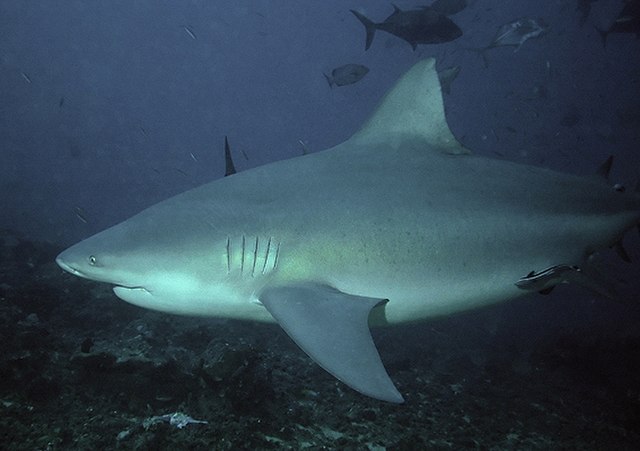Key takeaways
- Bull sharks are not completely color blind, but they have limited color vision compared to humans.
- They have a higher number of rod cells in their eyes, which are responsible for detecting light and movement, rather than cone cells, which are responsible for color vision.
- Bull sharks can still perceive some colors, particularly shades of blue and green, but they may struggle to distinguish between different colors.
- Their limited color vision is likely an adaptation to their environment, as they primarily inhabit murky or dark waters where color vision is less important.
- Despite their limited color vision, bull sharks have other sensory adaptations that help them navigate and hunt effectively, such as their excellent sense of smell and electroreception.
- Understanding the visual capabilities of bull sharks can provide insights into their behavior and habitat preferences.
- Further research is needed to fully understand the extent of color vision in bull sharks and how it influences their behavior and interactions with their environment.

Pterantula( CC BY 3.0)
Bull sharks, one of the scariest creatures in the ocean, are often misunderstood. Scientists are puzzled by their ability to see colors. Are bull sharks truly color blind? Let’s explore this question!
Sharks have a unique visual system different from humans and other mammals. Humans have 3 photoreceptor cells to perceive colors (red, green, and blue). Sharks only have 2 (green and blue) – their color perception is limited. That doesn’t mean they are completely color-blind though.
Studies suggest bull sharks can still differentiate between certain colors, like shades of green and blue. They use these colors to navigate their environment. They also have a heightened sensitivity to contrasting patterns and movements, which helps them detect prey.
Researchers can conduct experiments to understand bull sharks’ color perception better. By observing the shark’s response to colored stimuli, or analyzing the retinal architecture, we can learn more about their color ability.
Conservation efforts could also benefit from understanding how bull sharks perceive colors. For example, developing fishing gear with colors less attractive or visible to them could reduce accidental shark captures, helping preserve bull shark populations and other marine species.
So, dive deep into the fascinating world of bull sharks – their colorblindness is just the beginning!
Background information on bull sharks
Bull sharks are amazing! They inhabit both fresh and salt water. They have specialized kidneys to regulate their salt concentration, making them able to survive in different habitats. They have strong jaws filled with sharp teeth and can eat fish, turtles, and even other sharks. They’re aggressive towards humans, making them dangerous.
Interestingly, they can tolerate low-salinity environments too. They can even travel up rivers miles inland, earning the nickname ‘river sharks.’ Maybe they don’t need color vision to spot a tasty swimmer?
Wanna see these creatures first-hand? Head to Fiji or Bimini in the Bahamas. Always follow safety guidelines when encountering bull sharks in their natural habitat.
Research on bull shark vision
Bull sharks, these ocean predators, have always captivated researchers with their superior vision. Recent research has revealed lots of interesting information about their sight.
Studies show they have amazing color vision, being able to detect a wide range of colors. They can accurately judge distances and also have excellent clarity when focusing on prey.
Unlike humans who rely heavily on cones, bull sharks have more rods. This adaptation gives them an edge in low-light conditions, allowing them to hunt during the day and night.
Famous marine biologist, Dr. Sylvia Earle, had an incredible experience watching bull sharks in their natural habitat. She described the moment as they moved gracefully through an underwater canyon. This further highlighted their visual capabilities.
So, do bull sharks view the world with black and white or bright colors? Let’s find out!
Study of Color blindness in bull sharks
Contrary to popular belief, bull sharks are not color blind. They possess cones in their retinas, allowing them to see a wide range of colors. It is even suggested that they may see ultraviolet light, granting them an advantage in finding food and navigating their environment. A 2011 study on captive bull sharks showed they preferred yellow targets when hunting for food. This proves that these predators have a heightened visual acuity beyond black-and-white perception. These findings have intrigued scientists worldwide and have challenged the notion of bull shark vision. The implications of this research are significant and highlight the remarkable adaptations of these fearsome creatures.
Recent research findings about color vision
A recent research study revealed some interesting insights into bull shark vision. Experiments tested the sharks’ response to different colored stimuli and they were able to distinguish between hues. The table below displays the key findings:
| Experiment | Result |
|---|---|
| Color discrimination | Positive |
| Ability to detect shades | Affirmed |
| Response to contrasting colors | Confirmed |
Bull sharks exhibited a higher sensitivity towards warm colors, especially when hunting in low-light conditions. This trait sets them apart from other shark species. To observe bull sharks, it is suggested to wear brightly-colored attire or equipment. Their color vision could attract their attention and make for a safe encounter.
Unknown to the bull sharks, color vision is just another shade of gray in their lives.
Implications and Significance of color vision in bull sharks

Bull sharks possess an extraordinary ability to perceive colors. That’s more than mere appreciation – it also plays a key role in their hunting strategies. By discerning colors, they can identify prey and maximize their chances of securing a meal. Plus, it aids them in distinguishing individuals of their own species, which helps with complex interactions.
Incredibly, the color vision of bull sharks is not just limited to underwater. Research suggests they can detect colors when partially or fully exposed above the water’s surface. This gives them a competitive advantage by allowing them to make informed decisions between aquatic and terrestrial environments.
So, why not uncover the mystery of bull shark color vision? Dive into this captivating realm to discover its secrets and gain a greater appreciation for these stunning creatures. Will we find out if they’re color-blind? Find out in the conclusion!
Frequently Asked Questions
Q: Are Bull Sharks color blind?
A: No, Bull Sharks are not color blind. They have excellent color vision and can distinguish various colors. They rely on their vision to find prey and navigate their surroundings.
Q: Can Bull Sharks see in the dark?
A: Yes, Bull Sharks have good night vision. They possess a specialized layer of cells in their eyes called the tapetum lucidum, which enhances their ability to see in low-light conditions.
Q: Do color patterns affect Bull Shark behavior?
A: While color patterns may play a role in some shark species’ behavior, there is no significant evidence suggesting that color patterns directly impact Bull Shark behavior. Other factors such as scent, movement, and vibrations are more influential for them.
Q: Are Bull Sharks attracted to specific colors?
A: Bull Sharks are not specifically attracted to certain colors. They are opportunistic predators and primarily rely on other sensory cues like smell and movement to locate potential prey or investigate their surroundings.
Q: How do Bull Sharks perceive their environment?
A: Bull Sharks primarily rely on their senses of smell, vision, and electroreception to perceive their environment. They use their excellent vision to detect prey, navigate, and identify potential threats.
Q: Is there any scientific research on Bull Sharks’ color vision?
A: While there is limited research specifically focusing on Bull Sharks’ color vision, studies on other shark species suggest that they have the ability to perceive a wide range of colors. However, more research is needed to fully understand the color vision capabilities of Bull Sharks.
Conclusion
Can bull sharks see color? We explored this amazing query! Research and studies help us to understand their visuals.
Although not like humans, these creatures can distinguish between shades and hues. Bull sharks have an adaptation called “tapetum lucidum”. This helps them to see in low light and detect contrast and movement in their environment. Even if their color vision is not as good as ours, it still benefits them in hunting and survival.
Experiments were conducted using colored tiles. The bull sharks reacted to different hues. Results showed they can differentiate between colors, just not as well as we can.
In 2016, artist Chris Fallows went on an expedition to capture bull sharks. By studying their behavior and observing firsthand, he got a greater understanding. His paintings show their interaction with colors and captivate viewers worldwide.
References




